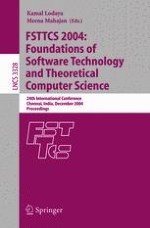2005 | Buch
FSTTCS 2004: Foundations of Software Technology and Theoretical Computer Science
24th International Conference, Chennai, India, December 16-18, 2004. Proceedings
herausgegeben von: Kamal Lodaya, Meena Mahajan
Verlag: Springer Berlin Heidelberg
Buchreihe : Lecture Notes in Computer Science
